Editor’s Note: Mainstream environmental organizations propose electric vehicles (EVs) as a solution to every environmental crisis. It is not only untrue, but a delusion. It does not matter to the hundreds of lives lost whether they were killed for extraction of fossil fuel for traditional internal combustion (IC) cars, or for extraction of materials necessary for manufacturing EVs. What matters is that they are dead, never to come back, and that they died so a portion of humans could have convenient mobility. DGR is organizing to oppose car culture: both IC and EVs.
By Benja Weller
I am a rich white man in the richest time, in one of the richest countries in the world (…)
Equality does not exist. You yourself are the only thing that is taken into account.
If people realized that, we’d all have a lot more fun.
ZDF series Exit, 2022, financial manager in Oslo,
who illegally traded in salmon
Wir fahr’n fahr’n fahr’n auf der Autobahn
Vor uns liegt ein weites Tal
Die Sonne scheint mit Glitzerstrahl
(We drive drive drive on the highway
Ahead of us lies a wide valley
The sun shines with a glittering beam)
Kraftwerk, Single Autobahn / Morgenspaziergang, 1974
Driving a car is a convenient thing, especially if you live in the countryside. For the first time in my life I drive a car regularly, after 27 years of being “carless”, since it was left to me as a passenger. It’s a small Suzuki Celerio, which I call Celery, and fortunately it doesn’t consume much. Nevertheless, I feel guilty because I know how disturbing the engine noise and exhaust fumes are for all living creatures when I press the gas pedal.
So far, I have managed well by train, bus and bicycle and have saved a lot of money. As a photographer, I used to take the train, then a taxi to my final destination in the village and got to my appointments on time. Today, setting off spontaneously and driving into the unknown feels luxurious.
However, my new sense of freedom is in stark contrast to my understanding of an intact environment: clean air, pedestrians and bicyclists are our role models, children can play safely outside. A naive utopia? According to the advertising images of the car industry, it seems as if electric cars are the long-awaited solution: A meadow with wind turbines painted on an electric car makes you think everything will be fine.
“Naturally by it’s very nature.” says the writing on an EV of the German Post, Neunkirchen, Siegerland (Photo by Benja Weller)
In Germany, the car culture (or rather the car cult) rules over our lives so much that not even a speed limit on highways can be achieved. The car industry has been receiving subsidies from the government for decades and journalists are ridiculed when they write about subsidies for cargo bikes.
Right now, this industry is getting a green makeover: quiet electric cars that don’t emit bad air and are “CO2 neutral” are supposed to drive us and subsequent generations into an environmentally friendly, economically strong future. On Feb. 15, 2023, the green party Die Grünen published in its blog that the European Union will phase out the internal combustion engine by 2035: “With the approval of the EU Parliament on Feb. 14, 2023, the transformation of the European automotive industry will receive a reliable framework. All major car manufacturers are already firmly committed to a future with battery-electric drives. The industry now has legal and planning certainty for further investment decisions, for example in setting up its own battery production. The drive turnaround toward climate-friendly vehicles will create future-proof jobs in Europe.”
That’s good news – of course for the automotive industry. All the old cars that will be replaced with new ones by 2035 will bring in more profit than old cars that will be driven until they expire. That the EU along with the car producers, are becoming environmentalists out of the blue is hard to believe, especially when you see what cars drive on German roads.
In recent years, a rather opulent trend became apparent: cars with combustion engines became huge in size and gasoline consumption increased, all in times of ecological collapse and global warming. These oversized SUVs are actually called sport-utility vehicles, even if you only drive them to get beer at the gas station. Small electric cars seem comfortable enough and have a better environmental footprint than larger SUVs. But the automotive industry is not going to let the new electromobility business go to waste that easily and is offering expensive electric SUVs: The Mercedes EQB 350 4matic, for example, which weighs 2.175 tons and has a 291-hp engine, costs €59,000 without deducting the e-car premium.
Comparing the Citroen 2CV and the Renault Zoe electric car shows that the Zoe uses about 8 times more kinetic energy. (Graph by Frederic Moreau)
If we look at all the production phases of a car and not just classify it according to its CO2 emmissions, the negative impact of the degradation of all the raw materials needed to build the car becomes visible. This is illustrated by the concept of ecological backpack, invented by Friedrich Schmidt-Bleek, former head of the Material Flows and Structural Change Department at the Wuppertal Institute for Climate, Environment and Energy. On the Wuppertal Institute’s website, one can read that “for driving a car, not only the car itself and the gasoline consumption are counted, but also proportionally, for example, the iron ore mine, the steel mill and the road network.”
“In general, mining, the processing of ores and their transport are among the causes of the most serious regional environmental problems. Each ton of metal carries an ecological backpack of many tons, which are mined as ore, contaminated and consumed as process water, and weigh in as material turnover of the various means of transport,” the Klett-Verlag points out.
Car production requires large quantities of steel, rubber, plastic, glass and rare earths. Roads and infrastructure suitable for cars and trucks must be built from concrete, metal and tar. Electric cars, even if they do not emit CO2 from the exhaust, are no exception. Added to this is the battery, for which electricity is needed that is generated at great material expense, a never-ending cycle of raw material extraction, raw material consumption and waste production.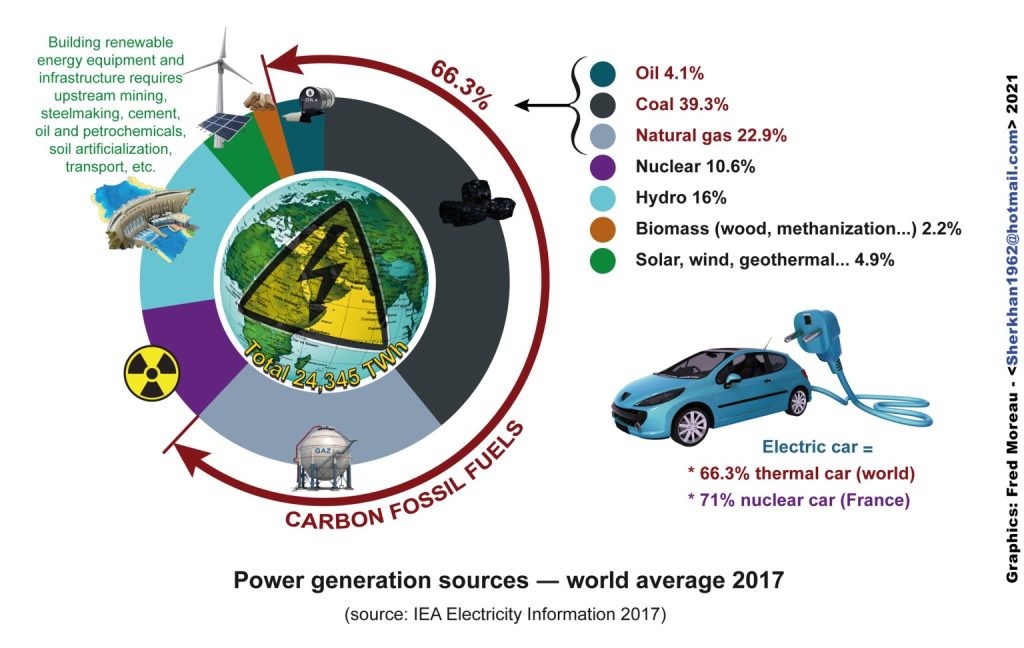
Power generation sources for electric vehicles (Graph by Frederic Moreau)
Lithium is a component of batteries needed for electric cars. For the production of these batteries and electric motors, raw materials are used “that are in any case finite, in many cases already available today with limited reserves, and whose extraction is very often associated with environmental destruction, child labor and overexploitation,” as Winfried Wolf writes in his book Mit dem Elektroauto in die Sackgasse, Warum E-Mobilität den Klimawandel beschleunigt (With the electric vehicle into the impasse, why e-mobility hastens climate change).
What happens behind the scenes of electric mobility, which is touted as “green,” can be seen in the U.S. campaign Protect Thacker Pass. In northern Nevada, a state in the western U.S., resistance is stirring against the construction of an open-pit mine by the Canadian company Lithium Americas, where lithium is to be mined. Here, a small group of activists, indigenous peoples and local residents have united to raise awareness of the destructive effects of lithium mining for electric car batteries and to prevent the lithium mine in the long term with the Protect Thacker Pass campaign.
Thacker Pass is a desert area (also called Peehee muh’huh in the native language of the Northern Paiute) that was originally home to the indigenous peoples of the Northern Paiute, Western Shoshone, and Winnemuca Tribes. The barren landscape is still home to some 300 species of animals and plants, including the endangered Kings River pyrg freshwater snail, jack rabbit, coyote, bighorn sheep, golden eagle, sage grouse, and pronghorn, and is home to large areas of sage brush on which the sage grouse feeds 70-75% of the time, and the endangered Crosby’s buckwheat.
For Lithium Americas, Thacker Pass is “one of the largest known lithium resources in the United States.” The Open-pit mining would break ground on a cultural memorial commemorating two massacres perpetrated against indigenous peoples in the 19th century and before. Evidence of a rich historical heritage is brought there by adjacent caves with burial sites, finds of obsidian processing, and 15,000-year-old petroglyphs. For generations, this site has been used by the Northern Paiute and Western Shoshone tribes for ceremonies, traditional gathering and hunting, and educating young Native people. Now it appears that the history of the colonization of Thacker Pass is repeating itself.
According to research by environmental activists, the lithium mine would lower the water table by 10 meters in one of the driest areas in the U.S., as it is expected to use 6.4 billion gallons of water per year for the next 40 years. This would be certain death for the Kings River pyrg freshwater snail. Mining one ton of lithium generally consumes 1.9 million liters of water at a time when there is a global water shortage.
The mine would discharge uranium, antimony, sulfuric acid and other hazardous substances into the groundwater. This would be a major threat to animal and plant species and also to the local population. Their CO2 emissions would come up to more than 150,000 tons per year, about 2.3 tons of CO2 for every ton of lithium produced. So much for CO2-neutral production! Thanks to a multi-billion dollar advertising industry, mining projects are promoted as sustainable with clever phrases like “clean energy” and “green technology”.
About half of the local indigenous inhabitants are against the lithium mine. The other half are in favor of the project, hoping for a way out of financial hardship through better job opportunities. Lithium Americas’ announcement that it will bring an economic boost to the region sounds promising when you look at the job market there. But there’s no guarantee that working conditions will be fair and jobs will be payed well. According to Derrick Jensen, jobs in the mining industry are highly exploitative and comparable to conditions in slavery.
Oro Verde, The Tropical Forest Foundation, explains: “With the arrival of mining activities, local social structures are also changing: medium-term social consequences include alcohol and drug problems in the mining regions, rape and prostitution, as well as school dropouts and a shift in career choices among the younger generation. Traditional professions or (subsistence) agriculture are no longer of interest to young people. Young men in particular smell big money in the mines, so school dropouts near mines are also very common.”
Seemingly paradoxically, modern industrial culture promotes a rural exodus, which in turn serves as an argument for the construction of mines that harm the environment and people. Indigenous peoples have known for millennia how to be locally self-sufficient and feed their families independently of food imports. This autonomy is being repeatedly snatched away from them.
Erik Molvar, wildlife biologist and chair of the Western Watersheds Project, says of the negative impacts of lithium mining in Thacker Pass that “We have a responsibility as a society to avoid wreaking ecological havoc as we transition to renewable technologies. If we exacerbate the biodiversity crisis in a sloppy rush to solve the climate crisis, we risk turning the Earth into a barren, lifeless ball that can no longer sustain our own species, let alone the complex and delicate web of other plants and animals with which we share this planet.”
We share this planet with nonhuman animal athletes: The jack rabbit has a size of about 50cm (1.6 feet), can reach a speed of up to 60 km/h (37mph) and jump up to six meters (19.7 feet) high from a standing position. In the home of the jack rabbit, 25% of the world’s lithium deposits are about to be mined. To produce one ton of lithium, between 110 and 500 tons of earth have to be moved per day. Since lithium is only present in the clay rock in a proportion of 0.2-0.9%, it is dissolved out of the clay rock with the help of sulfuric acid.
According to the Environmental Impact Statement from the Thacker Pass Mine (EIS), approximately 75 trucks are expected to transport the required sulfur each day to convert it to sulfuric acid in a production facility built on site. This means that 5800 tons of sulfuric acid would be left as toxic waste per day. Sulfur is a waste product of the oil industry. How convenient, then, that the oil industry can simply continue to do “business as usual.”
Nevada Lithium, another company that operates lithium mines in Nevada states: “Electric vehicles (EVs) are here. The production of lithium for the batteries they use is one of the newest and most important industries in the world. China currently dominates the market, and the rest of the world, including the U.S., is now responding to secure its lithium supply.” The demand for lithium is causing its prices to skyrocket: Since the demand for lithium for the new technologies is high and the profit margin is 46% according to Spiegel, every land available will be used to mine lithium.
Lithium production worldwide would have to increase by 400% to meet the growing demand. With this insane growth rate as a goal, Lithium Americas has begun initial construction at Thacker Pass on March 02, 2023. But environmentalists are not giving up, they are holding meetings, educating people about the destructive effects of lithium mining, and taking legal action against the construction of the mine.
Let’s take a look at the production of German electric cars.
Meanwhile, this is the third attempt to bring electric cars to the market in Germany. In the early 20th century, Henry Ford’s internal combustion engine cars replaced electric-powered cars on the roads.
Graph by Frederic Moreau
“In fact, three decades ago, there were similar debates about the electric car as today. In 1991, various models of electric vehicles were produced in Germany and Switzerland,” writes Winfried Wolf. “At that time, it was firmly assumed that the leading car companies would enter into the construction of electric cars on a large scale.”
He goes on to write about a four-year test on the island of Rügen that tested 60 electric cars, including models by VW, Opel, BMW and Daimler-Benz passenger cars from 1992 to 1996. The cost was 60 million Deutsche Mark. The Institute for Energy and Environmental Research (IFEU) in Heidelberg, commissioned by the Federal Ministry of Research, concluded that electric cars consume between 50 percent (frequent drivers) and 400 percent more primary energy per kilometer than comparable cars with internal combustion engines. The test report states that the Federal Environment Agency (UBA) in Berlin also sees its rejection of the electric car strategy confirmed.
There is no talk of these test results in times of our current economic crisis: also German landscapes and its water bodies must make way for a “green” economic policy. We can see the destructive effects of electric car production centers in the example of Grünheide, a town in Brandenburg 30 km from Berlin.
Manu Hoyer, together with other environmentalists in the Grünheide Citizens’ Initiative, rebel against the man who wants to discover life on other planets because the Earth is not enough: Elon Musk. She explains in an article by Frank Brunner in the magazine Natur how Tesla proceeded to build the Gigafactory Berlin-Brandenburg with supposedly 12,000 employees: First, they deforested before there was even a permit, and when it was clear that the electric car factory would be built, Tesla planted new little trees elsewhere as compensation.
The neutral word “deforestation” does not explain the cruel process behind it: Wildlife have their habitat in trees, shrubs and in burrows deep in the earth. In the Natur article, Manu Hoyer recalls that the sky darkened “with ravens waiting to devour the dead animals among the felled trees.”
In the book The Day the World Stops Shopping, J.B. MacKinnon describes, based on a study of clearing in Australia, that the scientific consensus is that the majority, and in some cases all, of the individuals living at a site will die when the vegetation disappears.
It doesn’t sound pretty, but it’s the reality when you read that animals are “crushed, impaled, mauled or buried alive, among other things. They suffer internal bleeding, broken bones or flee into the street where they are run over.” Many would stubbornly resist giving up their habitat.
In this, they are like humans. Nobody gives up her piece of land or his house without a fight when it is taken away from him; animals and humans both love the good life. But the conditions of wild animals play no role in our civil society, they should be available anytime to be exlpoited for our needs.
In order not to incite nature lovers, legal regulations are supposed to lull them into the belief that what is happening here is morally right. Behind this is a calculus by the large corporations, which in return for symbolic gestures can continue the terror against nature blamelessly.
In December 2022, Tesla was granted permission to buy another 100 hectares of forest to expand the car factory site to 400 hectares. The entire site had long been available for new industrial projects, although it is also a drinking water protection area. The Gigafactory uses 1.4 million cubic meters of water annually in a federate state plagued by drought.
Manu Hoyer tells Deutschlandfunk radio that dangerous chemicals are said to have leaked only recently and contaminated firefighting water seeped into the groundwater during a fire last fall. Another environmentalist, Steffen Schorcht, who studied biocybernetics and medical technology, criticizes local politicians for their lethargy in the face of environmental destruction. He sees no other way to fight back than to join forces with other citizens and international organizations outside of politics.
The beneficiaries are not the people who make up the bulk of the population. Tesla cars go to drivers who are happy to spend 57,000€ for a car with a maximum of 535 horsepower.
I can still remember how, as a child, I used to drive with my parents on vacation to the south of France, Italy or Austria in the Citroën 2CV model (two horsepower). Such a car trip was more adventure than luxury, but the experiences during the simple camping vacations in Europe’s nature have remained formative childhood memories.
The author sitting on the hood of a Citroën 2CV in Tuscany, Italy, 1989 (Photo: private)
Today, we have to go a big step further than just living a “simple life” individually. The car industry is pressing the gas pedal, taking the steering wheel out of our hands and driving us into the ditch. It’s time to get out, move our feet and stand up against the car industry.
The BDI, Federation of German Industries, writes in its 2017 position paper on the interlocking of raw materials and trade policy in relation to the technologies of the future that without raw materials there would be no digitalization, no Industry 4.0 and no electromobility. This statement confirms that our western lifestyle can only be financed through the destruction of the last natural habitats on Earth.
The mining of lithium and other so-called “raw materials” for new technologies is related to our culture, which imposes a techno-dystopia on the functioning organism Earth, that nullifies all biological facts. If we want to save the world, it seems to me, we should not become lobbyists for the electric car industry. Rather, we should organize collectively, learn from indigenous peoples, defend the water, the air, the soil, the plants, the wildlife, and everyone we love. The brave environmentalists in Grünheide and Thacker Pass are showing us how.
Homo sapiens have done well without cars for 200,000 years and will continue to do so. All we need is the confidence that our feet will carry us.
Wir fahr’n fahr’n fahr’n auf der Autobahn, Kraftwerk buzzed at the time
as an ode to driving a car
I glide over the asphalt to the points in lonely nature,
give myself a time-out from the confines of the small town
Bus schedules in German villages are an old joke
Buy me a Mercedes Benz, cried Janis Joplin devotedly,
without an expensive car, life is only half as valuable
Car-free Sundays during the oil crisis as a nostalgic anecdote
Driving means freedom and compulsion at the same time, asphalt is forced upon topsoil
with millions of living beings per tablespoon of earth
You must go everywhere: To the supermarket, to school, to work, to the store,
to the club, to friends, and to the trail park
Be yourself! they tell you, but without a car you’re not yourself,
on foot with a lower social status than on wheels
The speed limit dismissed each time, which party stands for the wild nature,
our ancient living room? Don’t vote for them, they deceive too
Believe yourself! they say, but what else can you believe, grown up believing
that this civilization is the only right one
Drive, drive, drive and the airstream flies in your hair –
Freedom, the one moment you have left
Featured image: A view of Thacker Pass by Max Wilbert


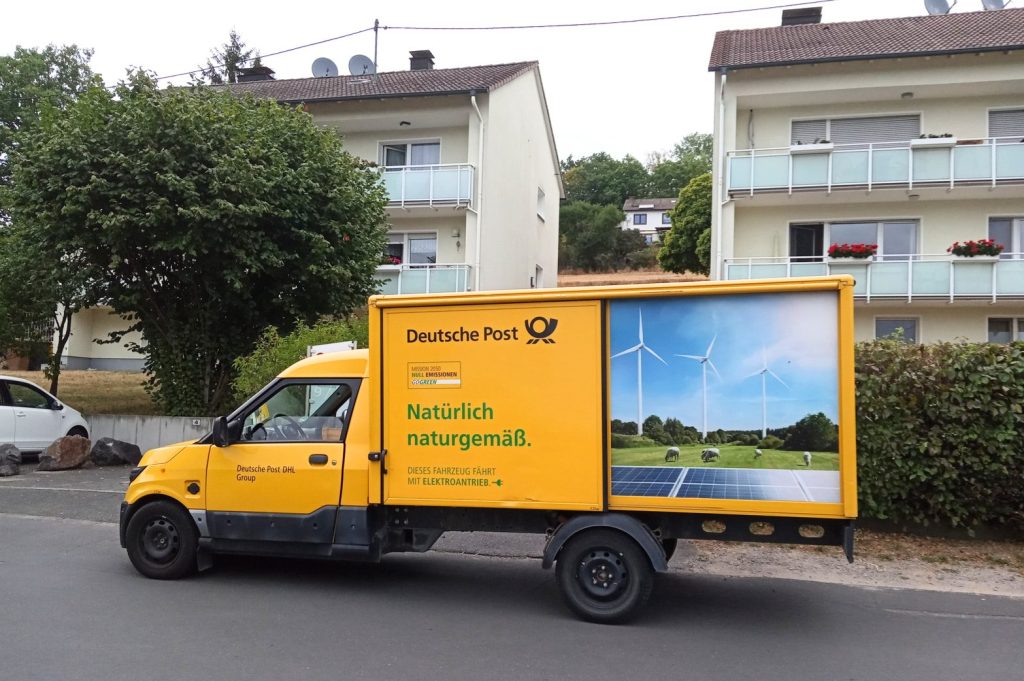
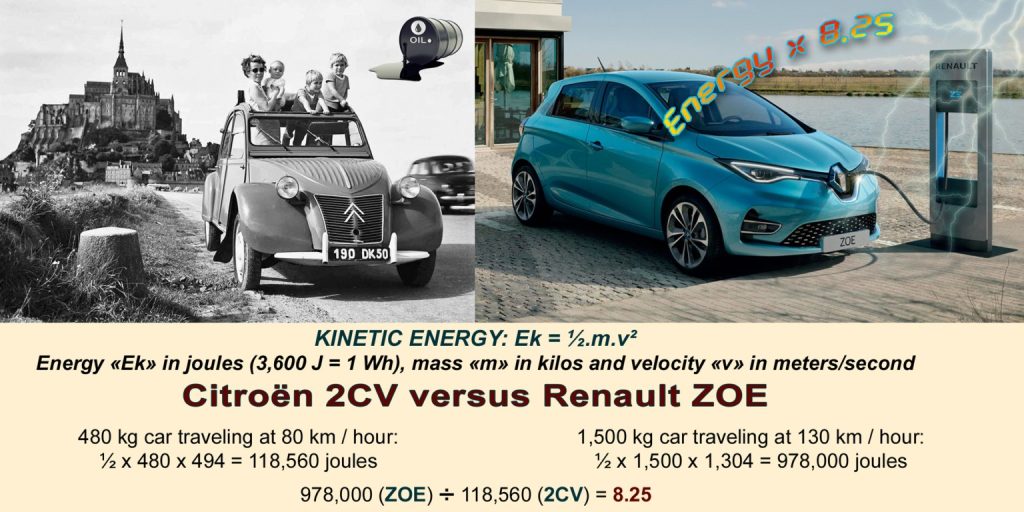
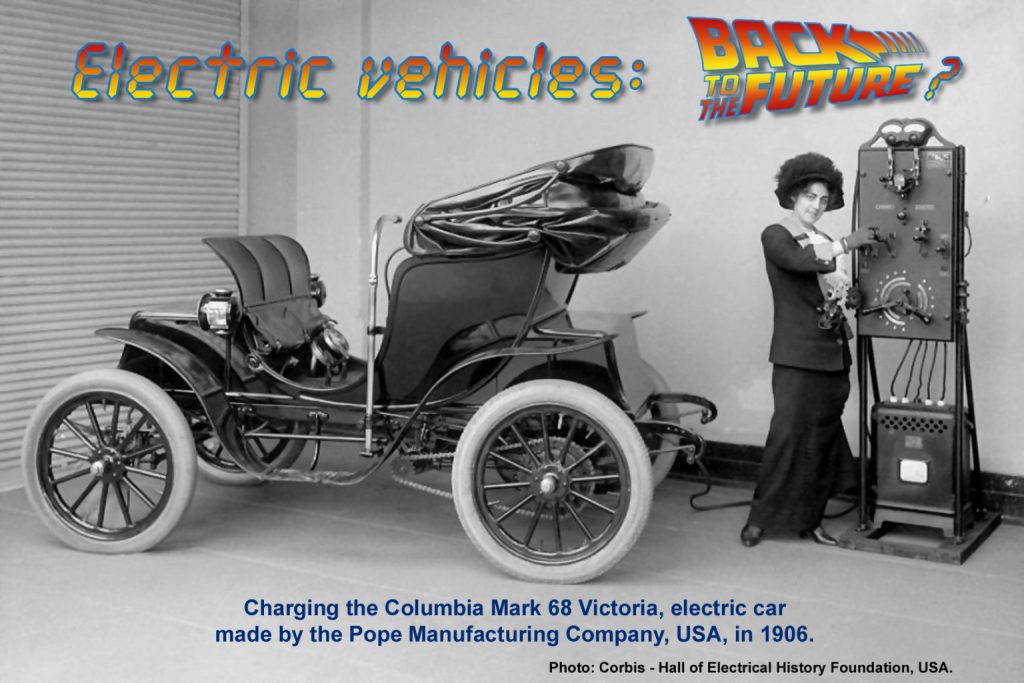
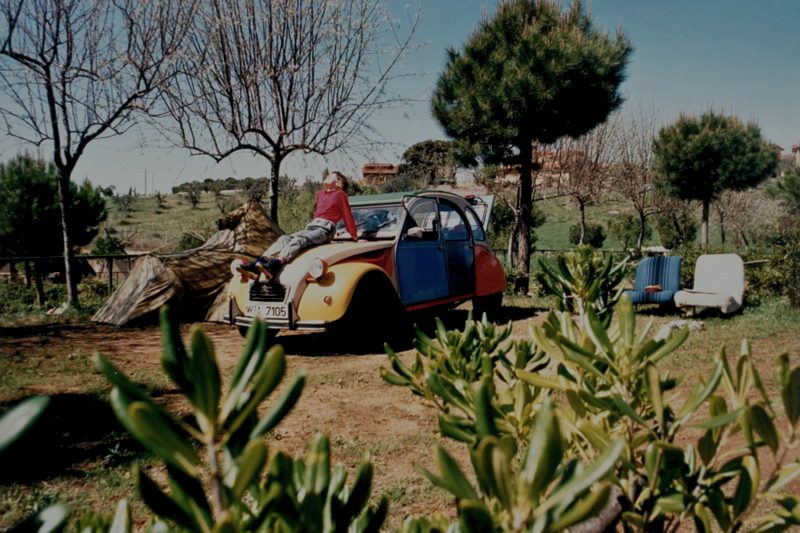
Reading this essay triggered many thoughts, but for the moment, I will comment that the damage to Thacker Pass would be far more harmful than what was described. Last week I attended a presentation by Suzanne Simard (an amazing scientist) and among other things, her slides vividly showed what immense damage is done by extractive activities, in her case clear cut logging. In the case of clear cut logging, if nothing more was done (as in continuing to harvest younger trees as they regrew), it would likely take CENTURIES (if ever) to return the land to the richness of the ecosystem created by old growth forest (above and below ground). In the case of mining activities, it’s not an overstatement to say these resources, including the land itself, are destroyed FOREVER. For those seeking jobs to provide food, shelter and other basic needs of life, we all need to assist in finding alternatives. There are groups out there working on that. And mining jobs, as has been noted, are short term. Once the mineral value has been extracted, and humans bear the health consequences, the employment opportunities there will only be worse. In any case, who are we humans, living at this time, to destroy hugely valuable (although not in capitalistic terms) resources that provide resilience to all living things on earth and will be necessary for the survival of those who follow us in this chain of being,
Hi Robert, thanks for your thoughtful comment and emphazising, that these wonderful habitats are lost forever and how irretrievable the destruction is. I also have a hard time understanding the behaviour of humans who just don’t care about a living planet.
It’s good to hear though that scientists like Suzanne Simard help to tell the truth behind “green” mining!
“DGR is organizing to oppose car culture …”
Good! I sold my last car more than 20 years ago, and even in my old age I get around by walking, biking, and public transit. I’m not totally car-free, as I drive my wife’s car occasionally, but it’s normally once/week to get my office mail, and is less than 10 miles round trip.
What people should do is organize their lives so that they don’t have to drive regularly, then give up their cars. It will take longer and it will obviously be physically harder to get around, but people will be healthier and, more important, it’s good for the Earth and the nonhuman life here. It will take more than our lifetimes to totally get rid of cars and driving, but if people just drove occasionally instead of regularly, that would be a big step in the right direction.
Hi Jeff, great to hear that you already gave up driving a car! I wish more people would understand the advantages of walking by foot for us humans, non-humans and the planet. What I see is that this culture makes it hard to switch, at least when you live on the countryside. That’s why it’s important to build local communities around our new way of mobility and to grow food locally, in my opinion.
Thanks for the article! Important info and conveyed compassionately. Government subsidies of automakers (corporations) is, by Mussolini’s definition, fascism, And the US highway system was originally called the Dwight D. Eisenhower National System of Interstate and Defense Highways, ‘inspired’ by the Reichsautobahn system. a project of the Nazis. And some roads have paved over what were once Native trails.
I appreciate your feedback, Mankh! What a terrible story that the US highway systems was built after the Nazi-Autobahn, I didn’t know that.